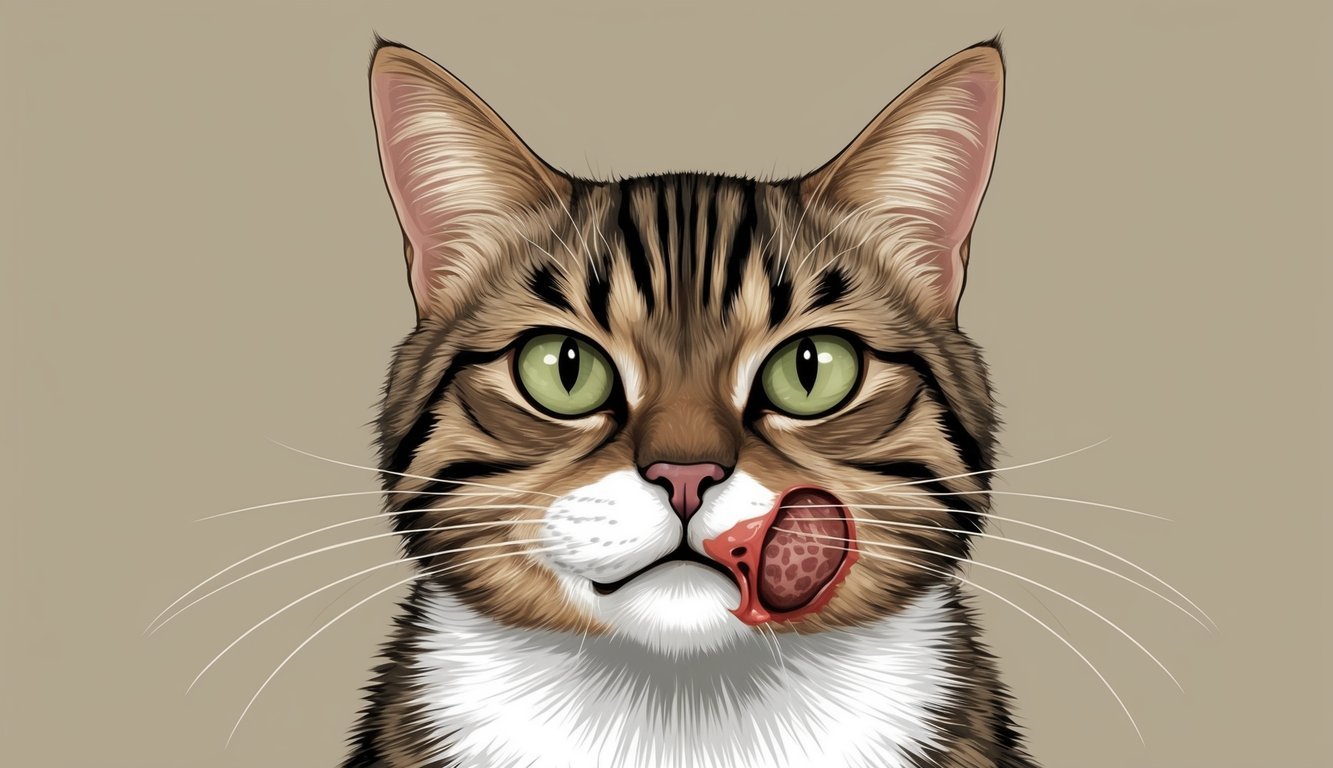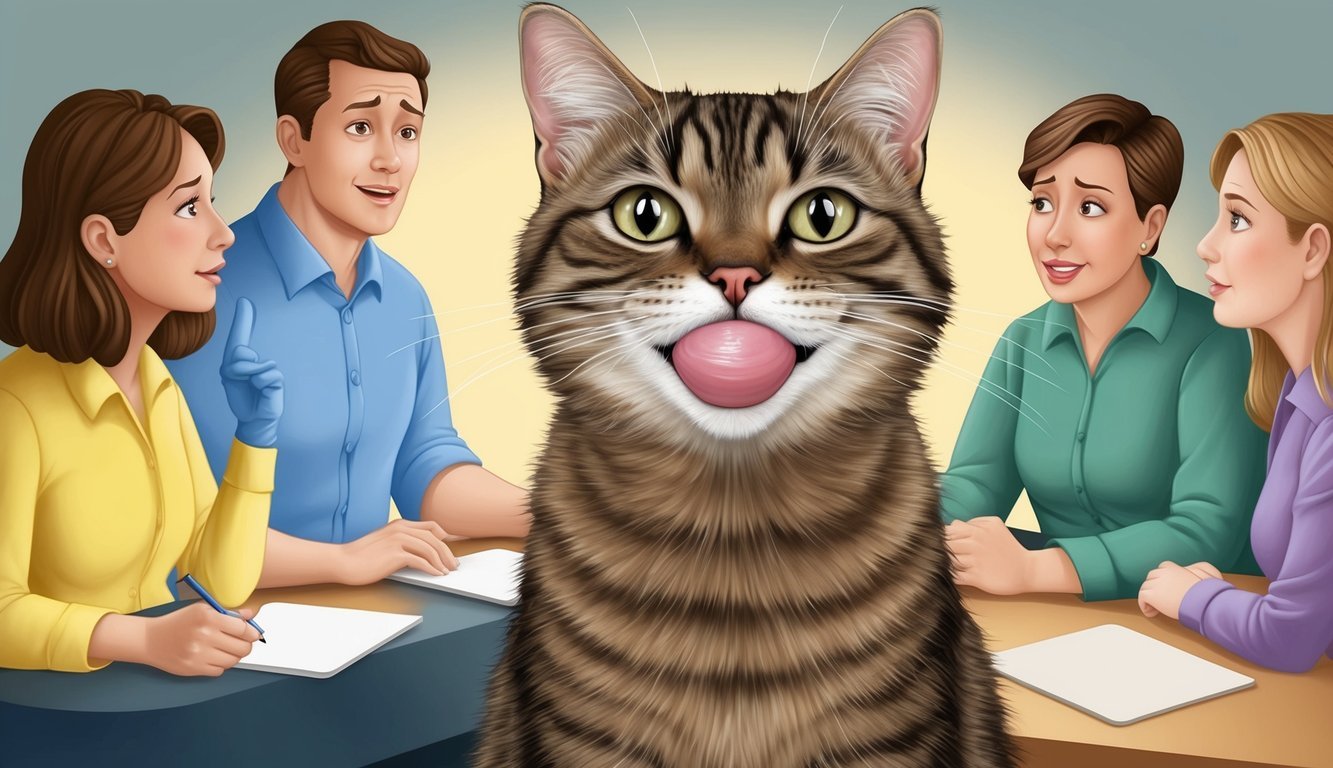Rodent ulcers in cats may look alarming, but they are relatively common and manageable.
These lesions often found on the upper lips indicate an underlying issue such as allergies or autoimmune responses.
Being informed about why these ulcers happen and how to treat them can significantly improve your cat’s comfort and health.
Understanding the causes and signs of rodent ulcers will empower you to take the necessary steps to support your feline friend.
Early detection and proper care are crucial in preventing their recurrence and minimizing discomfort.
If your cat shows any unusual sores, it’s essential to consult your veterinarian to determine the best action.
Whether you’re noticing symptoms for the first time or looking for ways to support an ongoing condition, this blog post will guide you through the ins and outs of rodent ulcers in cats, highlighting essential care strategies and answers to common concerns.
Key Takeaways
- Rodent ulcers are non-contagious lesions often linked to allergies.
- Early diagnosis is important for effective treatment and management.
- Keeping your cat’s health monitored can help prevent future outbreaks.
Understanding Rodent Ulcers
Rodent ulcers, also known as indolent ulcers, can be concerning for both you and your cat.
These lesions mainly affect the upper lip and form part of a broader condition known as the eosinophilic granuloma complex.
Let’s explore what these ulcers are, their symptoms, and what might trigger them.
Definition and Overview
Rodent ulcers are characterized by raised, swollen lesions that typically appear on the upper lip of your cat.
They belong to a group of conditions referred to as eosinophilic granuloma complex.
This complex includes eosinophilic plaques and other related skin issues.
These ulcers are not contagious, so you do not have to worry about them spreading among other pets.
Though the term “rodent ulcer” suggests a direct cause, many factors contribute to their development.
Symptoms and Signs
You may notice several signs if your cat has rodent ulcers.
Common symptoms include:
- Erythema (redness) around the affected area
- Swelling and raised lesions
- Discomfort or irritation leading to excessive grooming
Your cat might also show changes in behavior, such as decreased appetite or increased agitation.
If left untreated, these ulcers can become inflamed and larger, causing your cat additional discomfort.
It’s essential to monitor any changes in your cat’s mouth or lip area closely.
Underlying Causes and Triggers
Several factors can contribute to the development of rodent ulcers.
Common underlying causes include:
- Allergic reactions: Cats can develop hypersensitivity to various allergens, including food and environmental factors.
- Fleas: Flea bites may trigger an immune response leading to skin lesions.
- Genetic predisposition: Certain breeds may be more susceptible to developing these ulcers.
- Feline leukemia: This virus can compromise your cat’s immune system, increasing the chances of skin issues.
Understanding these causes helps in effectively addressing the condition and seeking appropriate treatment.
It’s important to consult with your veterinarian for a proper diagnosis and treatment plan tailored to your cat’s needs.
Diagnosing Rodent Ulcers
When assessing your cat for rodent ulcers, it’s essential to conduct a thorough evaluation.
This involves a physical examination, possibly a biopsy or allergy testing, and differentiating these ulcers from other similar conditions.
Physical Examination
The first step in diagnosing rodent ulcers is a comprehensive physical examination by your veterinarian.
They will start by looking for red, raised lesions on your cat’s upper lip and mouth area.
Key signs include:
- Loss of fur around the sores.
- Swelling and redness.
- Ulcers that may not appear painful.
Your vet will also check for any additional health issues that could indicate an underlying condition, such as allergies or infections.
It’s crucial to provide your vet with any relevant history, including recent changes in your cat’s environment or diet.
Role of Biopsy and Allergy Testing
In some cases, your veterinarian may recommend a biopsy to confirm the diagnosis.
This involves taking a small tissue sample from the ulcer for laboratory examination.
A biopsy can help rule out other conditions, such as squamous cell carcinoma.
Additionally, allergy testing can identify possible allergens contributing to the ulcers.
Testing can pinpoint sensitivities to food, environmental factors, or products your cat might be exposed to.
Addressing these underlying triggers can be a significant part of your cat’s overall treatment plan.
Differentiating From Other Conditions
Accurate diagnosis requires distinguishing rodent ulcers from other similar skin conditions.
Common conditions that can mimic rodent ulcers include fungal infections or malignant tumors like squamous cell carcinoma.
Your vet will perform a full assessment, taking note of specific characteristics of the ulcers.
For instance, rodent ulcers are often painless and not itchy, while other lesions might exhibit different signs.
Look for differences in lesion location, shape, and the overall health of your cat, as these details assist in reaching a definitive diagnosis.
Being proactive and observant can help ensure your cat receives the best care possible.
Treatment Strategies
When dealing with rodent ulcers in cats, you have several effective treatment strategies at your disposal.
These can include medical interventions, necessary dietary adjustments, and ongoing management techniques.
Each approach is crucial for ensuring the health and well-being of your feline friend.
Medical Interventions
For immediate relief, your veterinarian may prescribe corticosteroids or glucocorticoids to reduce inflammation and promote healing of the ulcers.
In some cases, veterinarians may suggest cyclosporine, particularly for indolent ulcers, which helps modulate the immune response effectively.
If an infection is present, antibiotics will be essential to prevent further complications.
Depending on the underlying cause—be it allergies or other conditions—your vet may tailor the treatment plan to address specific factors.
Regular veterinary check-ups are important to monitor the effectiveness of these medications and make adjustments as necessary.
Diet and Lifestyle Adjustments
Diet plays a significant role in managing rodent ulcers, particularly if food allergies are a factor.
A hypoallergenic diet can often be beneficial.
You might consider running dietary elimination trials to identify specific triggers that may be irritating your cat’s system.
Additionally, incorporating hypoallergenic cat food can minimize allergy responses.
Flea control is also critical, as flea saliva is a common allergen.
Implementing flea prevention measures—like topical treatments or oral medications—can significantly reduce the risk of flare-ups.
Ongoing Management and Prevention
Maintaining your cat’s health requires consistent management practices.
Regular veterinary check-ups allow for timely intervention and ensure that any new symptoms are addressed early.
You should regularly inspect your cat’s mouth for any signs of returning ulcers.
If they do reappear, consult your vet immediately.
Establish a structured approach to flea control and keep an eye on your cat’s diet—watching for any unusual reactions.
With consistent care and attention, you can help minimize the recurrence of rodent ulcers in your cat.
Complications and Prognosis

Rodent ulcers in cats can lead to some complications, and understanding the prognosis for your pet is essential.
Addressing symptoms early can reduce risks and improve outcomes.
Potential Complications
If left untreated, rodent ulcers can become infected, leading to bacterial infections.
Symptoms of infection include increased swelling, redness, or pus around the ulcer.
It’s vital to monitor your cat for these signs, as an infection can extend healing time and may require antibiotics.
Additionally, rodent ulcers can be linked to underlying conditions like autoimmune diseases.
If your cat exhibits persistent ulcers, it might indicate a more serious issue needing further investigation.
Maintaining your cat’s health through regular vet check-ups can help diagnose any potential complications early, allowing for timely treatment.
Outlook for Cats With Rodent Ulcers
The prognosis for cats with rodent ulcers varies based on the underlying cause.
If the issue stems from allergies or hypersensitivity, identifying and removing irritants can lead to a full recovery.
For many cats, a single episode may occur, while others may face recurring ulcers.
In cases linked to feline eosinophilic granuloma complex, results depend on successful treatment of the root cause.
Many cats respond well to appropriate interventions, and with the right care, you can help your feline friend achieve long-term health.
Regular veterinary evaluations and treatment adjustments can significantly enhance the chances of a positive outcome.
Support and Care for Cats with Rodent Ulcers
Caring for a cat with rodent ulcers requires attention and understanding of their needs.
You can significantly help your furry friend by creating a comfortable environment and ensuring regular veterinary support.
Home Care Recommendations
Creating a safe, stress-free space for your cat is crucial.
Consider their environment and eliminate potential environmental allergens like pollen or dust.
This might involve using air purifiers or keeping windows closed during high pollen seasons.
Monitor your cat’s behavior closely.
If you notice signs of stress or trauma, address these factors promptly.
Providing engaging toys can also help keep your cat calm.
Feeding your cat a balanced diet can support their immune system.
Consult your vet about any specific dietary recommendations.
If prescribed, administer medications like prednisone carefully, following the vet’s instructions for dosage and frequency.
Veterinary Follow-Up and Monitoring
Regular veterinary check-ups are important to monitor the progress of your cat’s condition.
At these visits, the vet can assess the ulcers and suggest any changes to treatment options.
If the cause is an allergy or infection, follow your vet’s guidance on eliminating triggers.
This might require a specific allergy test.
Keep records of any changes you observe in your cat’s behavior or the appearance of the ulcers.
Your vet may recommend topical treatments or changes in medication based on these observations.
Regular communication with your vet will ensure the best possible outcome for your cat’s health.
Frequently Asked Questions

When it comes to rodent ulcers in cats, you probably have several questions.
From symptoms to treatment options, understanding these aspects can help you care for your feline friend effectively.
What are the common symptoms of rodent ulcers in cats?
Rodent ulcers typically present as sores on your cat’s lips or mouth.
These lesions can appear red and swollen, and while they may bleed, many cats don’t show signs of pain or discomfort.
It’s essential to keep an eye on how your cat behaves to notice any changes.
Can you treat rodent ulcers in cats at home, and if so, how?
While you can perform some basic care at home, it’s best to consult a veterinarian for proper treatment.
You can clean the area gently with a saline solution.
Avoid using any harsh chemicals or medications without vet approval to prevent further irritation.
What types of food are recommended for cats suffering from rodent ulcers?
Soft, moist food is often easier for cats with rodent ulcers to eat.
Consider offering a diet that avoids allergens, which may contribute to the condition.
Look for high-quality commercial diets or consult your vet for specific recommendations tailored to your cat’s needs.
Is there a risk that rodent ulcers can lead to more serious conditions in cats?
Rodent ulcers themselves are not typically dangerous, but they can indicate underlying issues like allergies or other health conditions.
If you leave these ulcers untreated, they might become infected.
So, you need to monitor their progress to ensure your cat’s health.
How can I tell if my cat’s rodent ulcer is healing on its own?
You can look for signs such as reduced redness, decreased swelling, and the formation of new tissue over the sore.
If the ulcer begins to disappear or shows improvement after a few weeks, it may be healing.
Also, keep an eye on your cat’s overall behavior and appetite.
Can humans contract rodent ulcers from their feline companions?
No, rodent ulcers are not contagious at all.
They are a condition specific to cats and pose no risk to human health.
You can safely handle your cat without worrying about transmitting anything to yourself or others.

